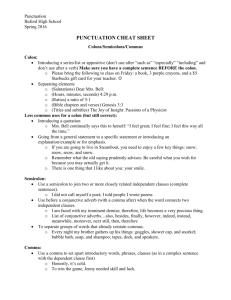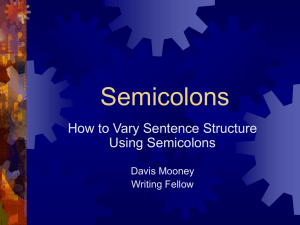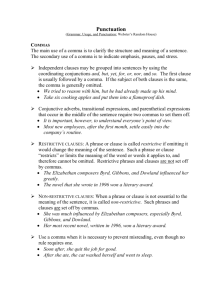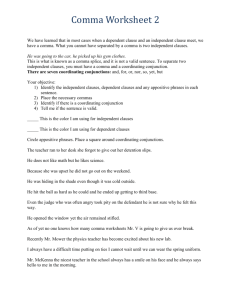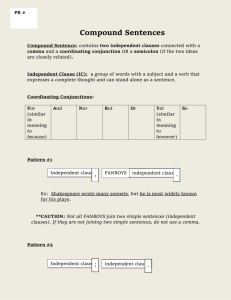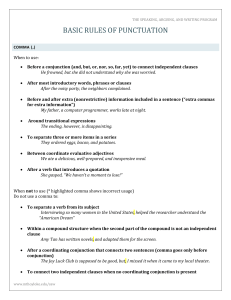Beaman Library 141 966.6301 7. Basic Comma and Semicolon Use
advertisement
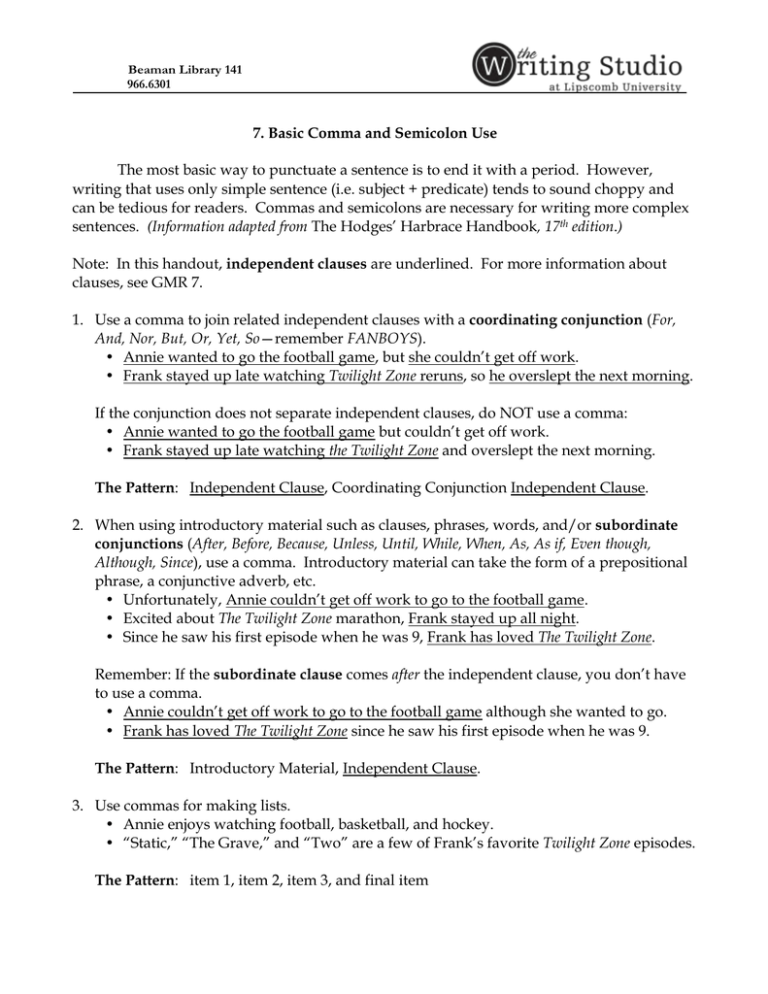
Beaman Library 141 966.6301 7. Basic Comma and Semicolon Use The most basic way to punctuate a sentence is to end it with a period. However, writing that uses only simple sentence (i.e. subject + predicate) tends to sound choppy and can be tedious for readers. Commas and semicolons are necessary for writing more complex sentences. (Information adapted from The Hodges’ Harbrace Handbook, 17th edition.) Note: In this handout, independent clauses are underlined. For more information about clauses, see GMR 7. 1. Use a comma to join related independent clauses with a coordinating conjunction (For, And, Nor, But, Or, Yet, So—remember FANBOYS). Annie wanted to go the football game, but she couldn’t get off work. Frank stayed up late watching Twilight Zone reruns, so he overslept the next morning. If the conjunction does not separate independent clauses, do NOT use a comma: Annie wanted to go the football game but couldn’t get off work. Frank stayed up late watching the Twilight Zone and overslept the next morning. The Pattern: Independent Clause, Coordinating Conjunction Independent Clause. 2. When using introductory material such as clauses, phrases, words, and/or subordinate conjunctions (After, Before, Because, Unless, Until, While, When, As, As if, Even though, Although, Since), use a comma. Introductory material can take the form of a prepositional phrase, a conjunctive adverb, etc. Unfortunately, Annie couldn’t get off work to go to the football game. Excited about The Twilight Zone marathon, Frank stayed up all night. Since he saw his first episode when he was 9, Frank has loved The Twilight Zone. Remember: If the subordinate clause comes after the independent clause, you don’t have to use a comma. Annie couldn’t get off work to go to the football game although she wanted to go. Frank has loved The Twilight Zone since he saw his first episode when he was 9. The Pattern: Introductory Material, Independent Clause. 3. Use commas for making lists. Annie enjoys watching football, basketball, and hockey. “Static,” “The Grave,” and “Two” are a few of Frank’s favorite Twilight Zone episodes. The Pattern: item 1, item 2, item 3, and final item Beaman Library 141 966.6301 4. Use commas to indicate nonessential elements (parts of a sentence that are not necessary for understanding the sentence). See The Hodges’ Harbrace Handbook 12d for a more detailed explanation and more examples of nonessential elements. “The Twilight Zone,” Frank’s favorite television series, began in 1959. Football, called American Football in other countries, is Annie’s favorite sport. 5. Because a semicolon carries more weight than a comma, semicolons can link together independent clauses. This should only be used when the two independent clauses are so closely related that you think they should be one sentence. Use this pattern sparingly! Jill felt uneasy on the farm at night; many animals could be lurking in its fields. Henry enjoys writing poetry; he likes to experiment with form and sentence structure. The Pattern: Independent clause; independent clause. Tip: When using this pattern, be sure your independent clauses are parallel. This will strengthen your writing! For more information on parallelism, refer to WTG 11. 6. Semicolons are also used before conjunctive adverbs (THINTIC: Therefore, However, Indeed, Nevertheless, Then, In fact, Consequently) when a conjunctive adverbs appears between two independent clauses. Place a semicolon before the conjunctive adverb and comma after it. Jill loves living on the farm; however, she feels uneasy about the many animals that could lurking around her house. Henry enjoys writing poetry; consequently, he spends at least an hour writing every day. The Pattern: Independent clause; conjunctive adverb, independent clause. REMEMBER: Do not use a semicolon here unless separating independent clauses. To do so would result in a sentence fragment! 7. Sometimes, it is necessary to use semicolons in list (if the list contains phrases or clauses with commas). In her spare time, Jill walks through the fields; plants vegetables, berries, and flowers in her garden; and plays with the dogs, cats, and horses on the farm. Henry writes satiric prose, poetry, and plays; watches horror, sci-fi, and comedic films; and listens to rock, bluegrass, and country music.

